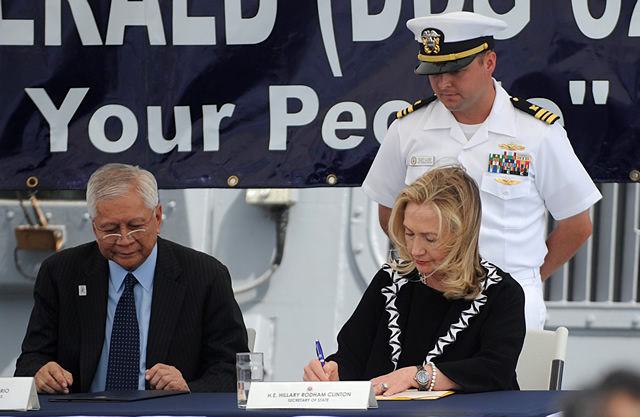U.S. Reaffirms Commitment to the Philippines: Another Ship on the Way
Robert Warshaw /

Secretary of State Hillary Clinton (R), beside Philippine Foreign Affairs Secretary Alberto del Rosario (L), signs a declaration marking the 60 years since the United States signed a security treaty with the Philippines on board the USS Fitzgerald, a US Navy destroyer, docked at the Manila bay on November 16, 2011.
Back in August, the Philippine Navy christened its newest flagship, the 115-meter Gregorio del Pilar, a refurbished former U.S. Coast Guard vessel built in 1965. Philippine Navy Chief Vice Admiral Alexander Pama stated that this Hamilton-class cutter “symbolizes the revival of the Philippine Navy.”
And that revival will soon continue with a second U.S. cutter, exactly like the first and delivered virtually free of charge.
Secretary of State Hillary Clinton made the announcement during an alliance-boosting visit to Manila following the Asia–Pacific Economic Cooperation (APEC) meetings in Hawaii. Celebrating the 60th anniversary of the U.S.–Philippine Alliance, Clinton promised that the second vessel would be transferred to the Philippines sometime next year.
Indeed, she went a step further in reaffirming U.S. commitment to its longstanding ally. In Manila Bay, aboard the USS Fitzgerald, a guided missile destroyer, Clinton signed the Manila Declaration, which reaffirms obligations under the U.S.–Philippines Mutual Defense Treaty. Clinton also expressed that “the United States is working…to support the Philippines particularly in the maritime domain as you move to improve territorial defense and interdiction capabilities,” something The Heritage Foundation has specifically and consistently encouraged.
The optics of this moment should not be lost on anyone. The Philippines has been embroiled in a territorial dispute with China in the South China Sea, suffering numerous incursions and harassment by Chinese vessels over the last year, and prompting more concerted efforts toward securing its own territorial sovereignty. The U.S. standing side by side with its ally on the deck of a warship sends a powerful message to the entire region that, as Clinton stated, “the United States will always be in the corner of the Philippines.”
In this context, transferring another former Coast Guard cutter to the Philippines makes sense both symbolically and militarily. The Philippine Navy is in woeful need of modernization. Two 1965 cutters actually go a long way toward improving the capacity of the Philippine fleet. Cutters are highly versatile vessels with impressive range and longetivity and can operate under a range of conditions—perfect for patrolling the vast maritime territory of the archipelagic Philippines, as well as disputed areas in the Spratly Islands. They should be just the start.
The American commitment to the Asia–Pacific region is critical for the Philippines, and it should be followed by sustained effort.
First, regarding maritime cooperation, the U.S. should give the Philippines priority access to excess defense articles—namely, a third cutter—and explore lend-lease options for other systems. Like the antiquated cutters, mothballed U.S. ships and airplanes will contribute to regional stability if refitted, refurbished, and operated by the Philippines, as opposed to simply decaying in an American boneyard.
Second, despite budget cuts, the U.S. should increase ship and aircraft visits, expand joint exercises, increase Foreign Military Financing (FMF), and maintain U.S. Special Forces presence in Mindanao until the job is done.
Third, the Philippines merits a presidential visit, and despite the demands of an election year, President Obama should demonstrate U.S. commitment by visiting at some point in 2012.
In essence, the second cutter that the U.S. plans on transferring to the Philippine Navy can be seen as a microcosm of U.S. commitment toward both the alliance and regional security. Secretary Clinton should be commended for seeing that. Her powerful gesture should be followed by consistent, high-level engagement and material support for the modernization of the Armed Forces of the Philippines.
Clinton unequivocally stated that “we will always stand and fight with you to achieve the future we seek.” That’s a serious commitment on the part of the U.S. We have to stand by it.
